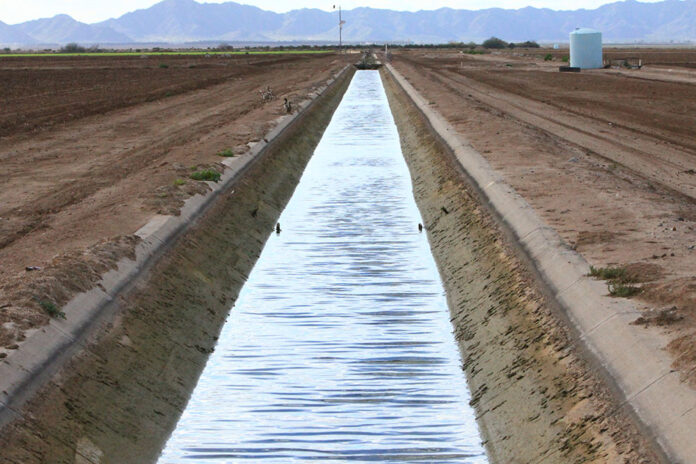Drought and global warming are combining to turn Arizona’s dream into a mid-summer nightmare.
According to many climatologists, Arizona is in the worst drought in more than 1,000 years, based on tree-ring studies. Maricopa City Councilman Marvin L. Brown said the state is already into a severe water crisis.
Brown serves on the Pinal County Water Augmentation Authority, which has a presence in and provides input on state and regional water issues. Representatives from cities in Pinal County sit on the board.
“Even with Global Water’s very sophisticated process of cleansing, I give Arizona 30 years, if that long,” Brown said. “I don’t even think it will be that long. Lake Mead seriously is distressed. We are not getting the snowfall that we’re used to getting. We’re not getting the rain. I don’t think I’m being pessimistic, I am being realistic.”
Maricopa’s Water Outlook
Meanwhile, Maricopa’s future looks solid compared to the rest of the state because of water.

“Global Water has a really great supply,” said Jake Lenderking, Global Water Resources director of Water Resources. “They have a designation of an assured supply for our service area and for growth in our service area.”
Lenderking said because Maricopa is a relatively new city, Global has been able to design a unique and efficient water delivery and sewer system.
“We have water, and nobody else does,” City Manager Rick Horst said at a Maricopa City Planning & Zoning Commission meeting Feb. 7. “The message that is going out to all the world is ‘Arizona has a 20-year drought and they have a water problem.’ All the headlines say we’re in trouble, but we are not.”
“I actually agree with that,” said Brian Betcher, general manager of the Maricopa-Stanfield Irrigation and Drainage District. “The city of Maricopa is sitting on some of the best groundwater. This is groundwater that I use to supply to farmers. This is the shallowest groundwater in the area. The farther south and east you go, the deeper it gets. This is our most-abundant and least-expensive water supply.”
He said Pinal County is a great place to grow crops, if you have the water to do it. That is a big “if.”
Pinal County Agriculture at a Minimum
In Arizona’s newly passed Drought Contingency Plan (DCP), farmers in Pinal County stand to lose two-thirds of the irrigation water they have been receiving from the Colorado River.
The DCP is an effort to keep the Colorado River’s major reservoirs from reaching catastrophically low levels. DCP goes into effect when levels in Lake Mead hit a specified low level of 1090 MSL (mean sea level). Lake Mead is currently at 1085 MSL, meaning water experts believe Arizona will likely lose quite a bit of their Colorado River allocations in 2020.
Betcher testified twice before state legislative committees as they were forging the DCP.

“Happy is not a great word,” he said. “(I am) satisfied that they preserved what was agreed to in the steering committee.”
Betcher said the agricultural industry in Arizona got the minimum amount of water necessary to keep ag alive in the agreement.
“It is the best that we could probably do in this environment. It is important to the state that the DCP gets done. We (ag) are the lowest-priority, water-user group. There stands to be a huge potential for economic loss in the ag community in Pinal County,” Betcher said.
Without a drought plan in place, Arizona would still lose a total of 320,000 acre-feet of water from the Colorado River. When the DCP is fully triggered, in the event Lake Mead gets below 1075 MSL, an extra 192,000 acre-feet will be held back. This means Arizona effectively loses 512,000 acre-feet of water from the Colorado River if the drought continues.
In a hypothetical irrigation water loss study, the University of Arizona found the effects on Pinal County and its economy could be enormous. If there were a loss of 300,000-acre feet of water in the county, the study estimated:
- $63.5 million to $66.7 million (7 percent) loss in gross, farm-gate sales
- $94 million to $104 million loss in total county sales
- $31.7 million to $35 million loss in county value added (e.g. net farm income, profits in other industries, employee compensation and tax revenues)
- 240 to 480 full- and part-time jobs lost
Currently, producers in the Maricopa-Stanfield Irrigation and Drainage District receive 82,000 acre-feet annually. That would be reduced to about 35,000 acre-feet from the Colorado River under DCP.
Betcher told district members 30 to 40 percent of lands in the area could go fallow and not be farmed. He said Colorado River water cutbacks to 105,000 acre-feet in the CAP system will take Pinal County agriculture “right to the edge of sustainability.”
Assured Water Supply
“A landowner or certain water utilities like us get designated as having an assured supply,” Lenderking said. “You have to prove to the Department of Water Resources that you have a 100-year assured supply. When you prove that, you get a certificate or, like here in Maricopa, we went and got a designation under the utilities, and the landowner doesn’t have to prove it. We have it for our whole service area that we have 100 years of assured supply.”
He said this means Global Water can serve an adequate amount of water to Maricopa for 100 years.
“We have the right to pump the groundwater beneath us,” Lenderking said. “To say that it is there for 100 years, we had to actually prove through groundwater modeling that it exists. That water is there.”
For Brown, however, it’s not just water supply that will impact the ability to grow. He said he doesn’t see any way out of insufferable drought and heat for the entire Southwest in the next 30 years. He said temperatures could hit “135 to 140 degrees.”
“Climate change is real. The drought will, more than likely, continue. Since I’ve been here, the summers have been longer and hotter.”
This story appears in the March issue of InMaricopa.



![Affordable apartments planned near ‘Restaurant Row’ A blue square highlights the area of the proposed affordable housing development and "Restaurant Row" sitting south of city hall and the Maricopa Police Department. Preliminary architectural drawings were not yet available. [City of Maricopa]](https://www.inmaricopa.com/wp-content/uploads/2024/04/041724-affordable-housing-project-restaurant-row-218x150.jpg)












![Affordable apartments planned near ‘Restaurant Row’ A blue square highlights the area of the proposed affordable housing development and "Restaurant Row" sitting south of city hall and the Maricopa Police Department. Preliminary architectural drawings were not yet available. [City of Maricopa]](https://www.inmaricopa.com/wp-content/uploads/2024/04/041724-affordable-housing-project-restaurant-row-100x70.jpg)

